When launching a store or adding to your product range, WooCommerce import products becomes essential. WooCommerce provides multiple ways to handle this process, from simple CSV uploads to full-scale migrations.
There are 3 ways to import products to WooCommerce:
Without further ado, let’s get started!
WooCommerce Import Made Easy!
Let our experts handle the migration while you focus on growing your business.

How to Perform WooCommerce Import Products Using CSV Files?
WooCommerce comes with a built-in CSV importer that lets you add or update products in bulk. Instead of creating items one by one, you can upload all your product details at once using a spreadsheet file.
This method is best for store owners who already have their product data in a spreadsheet or are migrating from another platform that can export products into CSV format. It’s also a good fit if you want a quick, no-plugin solution for handling bulk product uploads or updates.
Here’s a concise wrap-up of the WooCommerce product import process using CSV files, summarized by each key step:
- Step 1: Prepare your CSV file;
- Step 2: Upload your CSV file;
- Step 3: Import products into WooCommerce;
- Step 4: Update existing products (Optional);
- Step 5: Convert simple to variable products (Optional).
Step 1: Prepare your CSV file
Before you begin, you need a CSV file prepared with all the necessary product information for import into WooCommerce. You can create this file in a few different ways:
- Export a product CSV from your existing store.
- Download a sample CSV file from GitHub and replace the example data with your own product details.
- Create a CSV file on your own, even if it only includes some basic fields such as product name, price, and description.

At the very minimum, your WooCommerce import CSV file should include these basic fields:
- Name: the product’s title as it will appear in your store.
- SKU: a unique identifier for each product.
- Short description: a quick summary that usually shows near the price and Add to Cart button.
- Description: the main product description, often used for detailed info.
- In stock? / Stock: lets you show availability or inventory levels.
- Regular price: the standard selling price of the product.
- Sale price (optional): a discounted price, if you’re running promotions.
- Categories: used to organize products into groups in your store.
- Tags (optional): keywords that help with filtering and SEO.
If you choose to create the CSV file manually, make sure it complies with WooCommerce’s general formatting and data requirements. Here are the 7 key reminders:
- Ensure your WooCommerce import CSV is in UTF-8 format.
- Set dates according to your store's local time zone.
- Use 1 or 0 in your CSV when importing a Boolean value (true or false).
- Separate multiple values in a field with commas
- Wrap values in quotes if they contain a comma.
- When referencing an existing product ID, prefix it with “id:” (for example, id:100)
- Use “>” to indicate hierarchy in taxonomy terms, and separate these terms with commas.
However, the steps for WooCommerce import products with images aren’t as straightforward. More specifically:
- Images must be pre-uploaded or hosted online to be imported into your WooCommerce store.
- External image URLs are supported, as long as they are directly accessible and not redirected (which is common with some cloud storage links).
- If the image already exists in your Media Library, you can reference it by specifying its filename.
- The core WooCommerce CSV importer does not support adding, editing, or updating alt text for product images.
Step 2: Upload your CSV file
After finishing your CSV file, navigate to All Products > Products in your dashboard. Then, click on the Import button at the top of the page, which will bring up the CSV upload screen.
Next, select Choose File and upload the CSV file containing your product data. If this CSV file uses a different symbol to separate data (e.g., a semicolon instead of a comma), type that symbol into the “CSV delimiter” box under the Advanced settings.
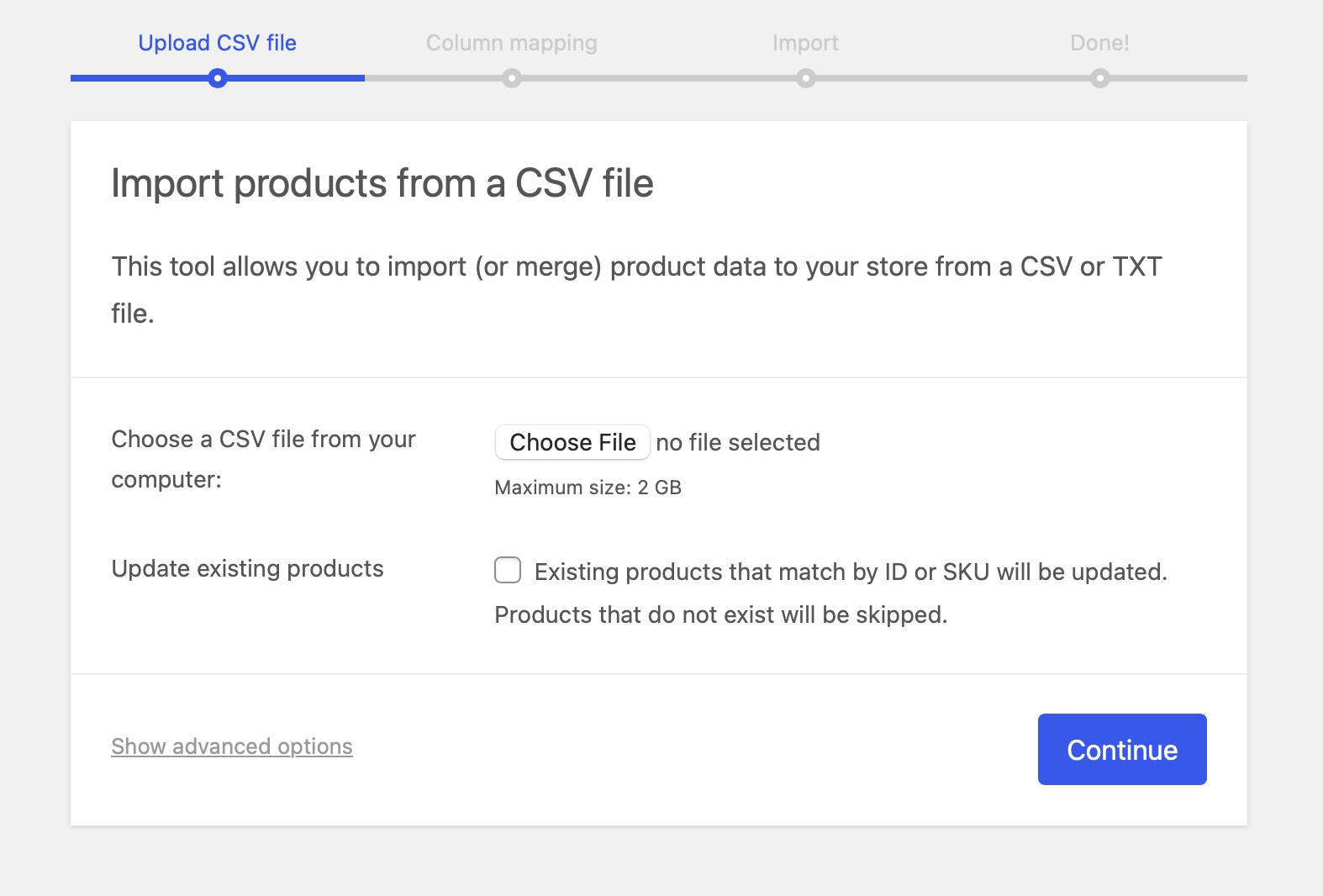
Once selected, click Continue to proceed with the import products WooCommerce process.
Please note that the maximum file size allowed is 2GB. This limit may pose issues for stores with a large product catalog, as oversized files could fail to upload or slow down the import. Thus, for stores with high-volume catalogs or limited technical resources, we highly recommend our LitExtension's All-in-One Migration Service to avoid these constraints.
Step 3: Import products into WooCommerce
On the follow-up screen, WooCommerce will automatically match the columns from your CSV file with the correct fields.
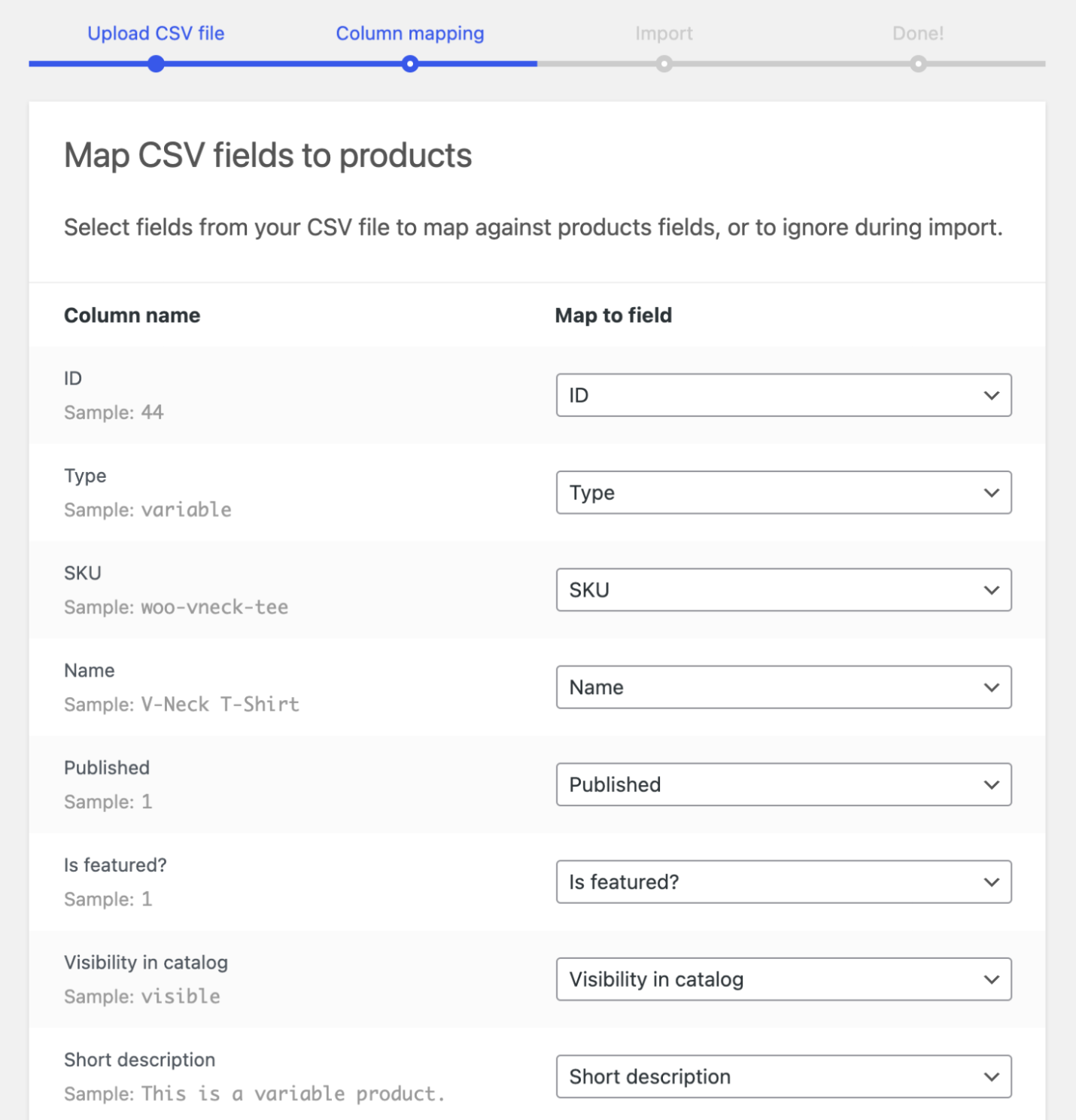
You can use the dropdown menus on the right side to modify these matches (or choose “Do not import” for columns you don't want to include). Any columns that WooCommerce doesn't recognize will be skipped by default.
After that, click “Run the importer” to upload the products to WooCommerce. Do not refresh or leave the page until the import concludes!
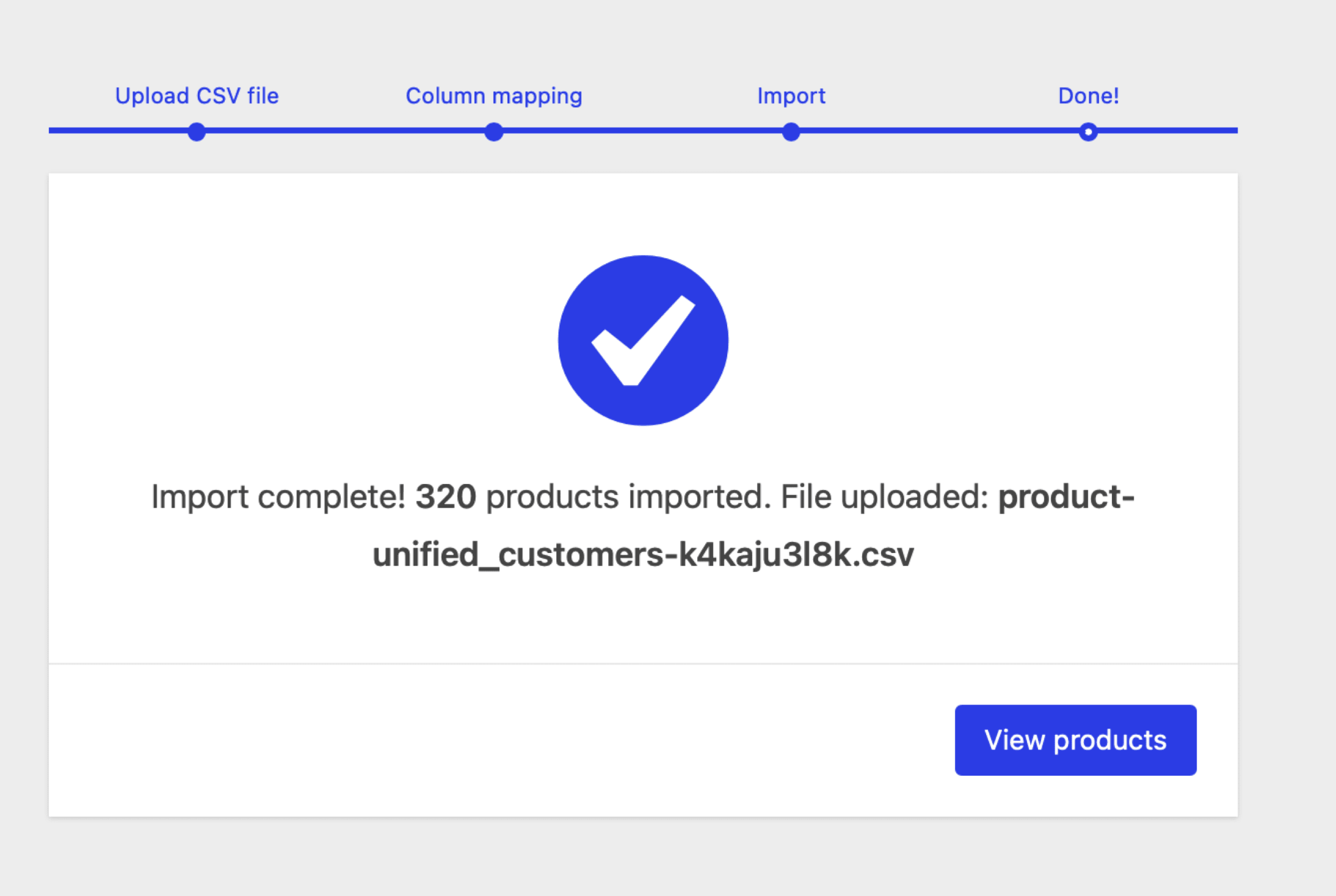
Step 4: (Optional) Update existing products
Note: This step is only necessary if you need to update existing products. If you're uploading new products, feel free to skip it.
At some point after your initial import, perhaps ahead of major sales like Black Friday or Christmas, you might want to update your product listings with fresh details. Fortunately, you can still use the same CSV importer tool for these changes! Here's how:
- First, create a CSV file (just like in Step 1) that includes the SKUs or IDs of the products that need updates. The WooCommerce importer will later use them to match and update the products in your store.
- Next, go to All Products > Products > Import to bring out the “Upload CSV file” screen. Next, click “Choose file” to select the file you want to use.
- Tick the “Update existing products” checkbox. Then, click “Continue” and repeat Step 3 above to complete your update.
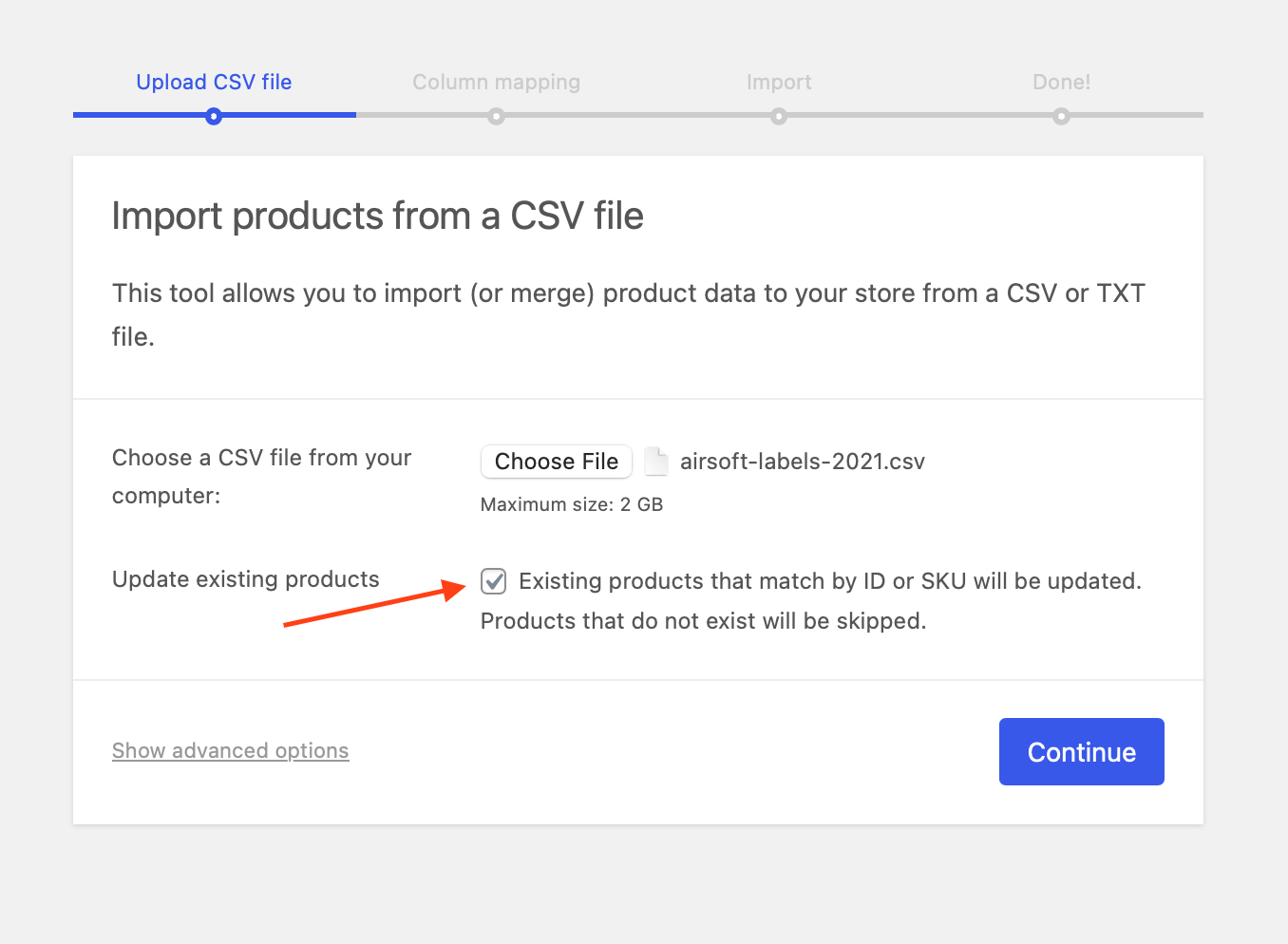
Step 5: (Optional) Convert simple to variable products
Note: This step is only relevant if you need to convert simple products to variable ones (e.g., adding sizes or colors). If this doesn’t apply to your case, feel free to skip it.
Additionally, you can also convert a simple product into a variable one using the same CSV import method. To start with, you need to export the list of your simple product on WooCommerce. Next, open the CSV file and begin editing:
- Add two new rows: one for each variation (e.g., size S and M). Keep the original row.
- Insert four new columns:
Attribute 1 nameAttribute 1 value(s)Attribute 1 visibleAttribute 1 global
- In all three rows, set
Attribute 1 nameto Size. - For the original row, list all values (e.g., S, M) in
Attribute 1 value(s). - In each variation row, specify a single value (e.g., S in one, M in the other).
- Set
Attribute 1 visibleto 1 andAttribute 1 globalto 0 for all rows.
Moving on, we will need to update the Type column:
- Change the original product’s type to
variable. - Set the two new rows as
variation. - Assign each variation a unique SKU and name.

- Make sure the Parent column for variations matches the SKU of the parent product.
Now, go back to WooCommerce and open the CSV Importer. Upload the updated CSV file and check the box for “Update existing products”, this is important because you're modifying the original product.

- Proceed with the import.
- No field mapping is needed if your columns follow the WooCommerce schema.
- After the import, visit the product page. You’ll see that the product is now of type variable and includes the attribute (e.g., Size).
However, you won’t see the variations yet, that’s expected. WooCommerce does not create variation entries in this step because the parent row is treated as the product being updated, not as a controller for new variation rows.
Next, open your CSV file again and delete the parent product row, leaving only the two variation rows.

- Save this as a new CSV file.
- Go back to the CSV Importer and upload this version.
- This time, do NOT select “Update existing products.” You’re importing the variation rows as new products, and WooCommerce will match them to the parent product using the Parent SKU field.
Now, when you go back to the product in WooCommerce, you’ll see the full variable product setup, with both the attribute and the associated variations correctly linked and functioning.

How to Import WooCommerce Products with LitExtension Experts?
If you’d rather skip the manual work, you can hand the process over to professionals. Our LitExtension experts are here to help!
With our CSV Files Migration Service, your project will be handled by a Personal Assistant (PA). who takes care of everything for you. They will review your CSV file, map all the fields correctly, and directly import every product detail into WooCommerce.
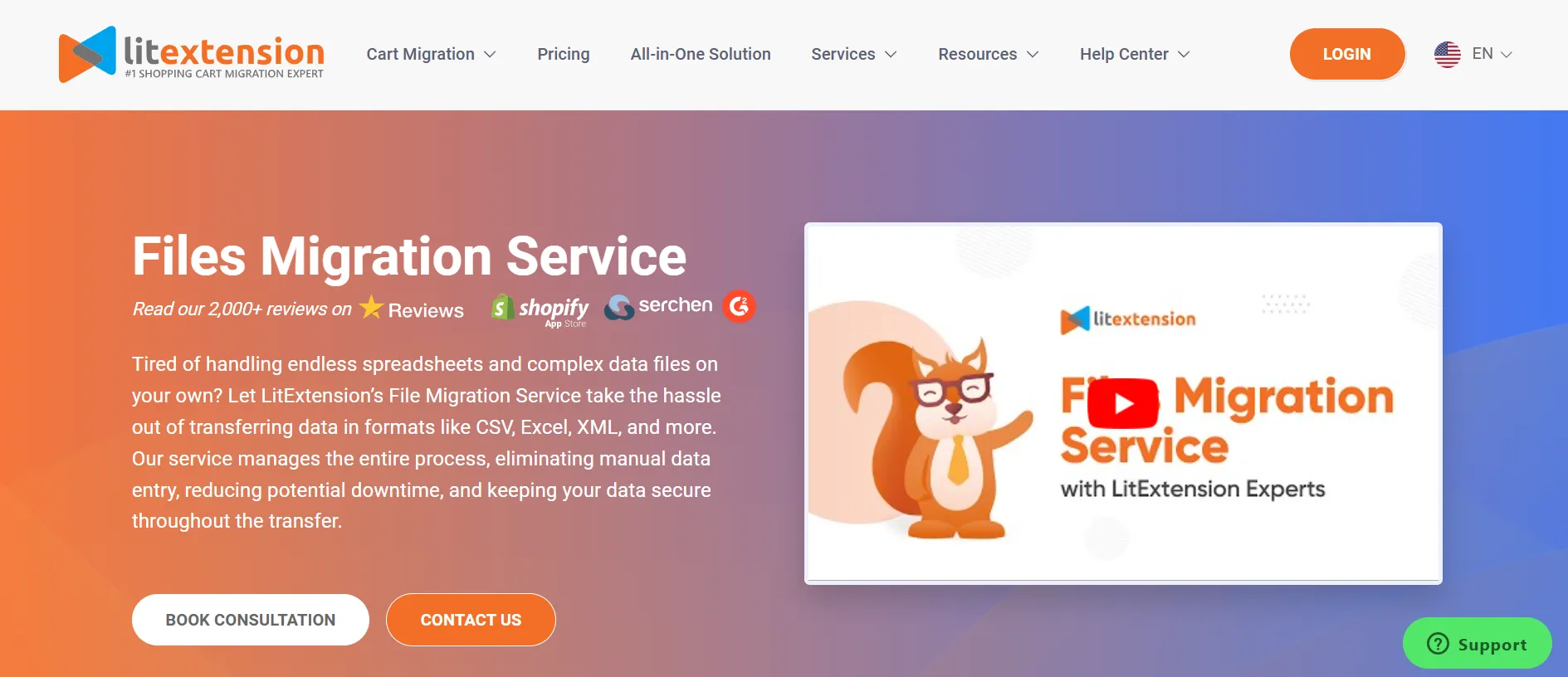
This way, you don’t need to lift a finger; the product migration is done for you quickly, securely, and with expert care.
To import products into WooCommerce, our experts will perform the following four steps:
- Step 1: Receive consultation from our experts
- Step 2: Customize & run a demo migration
- Step 3: Perform the full migration
- Step 4: Test the results
Step 1: Receive consultation from experts
To kick things off, we’ll need to understand exactly what kind of product data you’re working with. You’ll be scheduled to a 1-on-1 consultation where a LitExtension expert will review your CSV file, ask a few questions about your goals, and walk you through the process ahead.
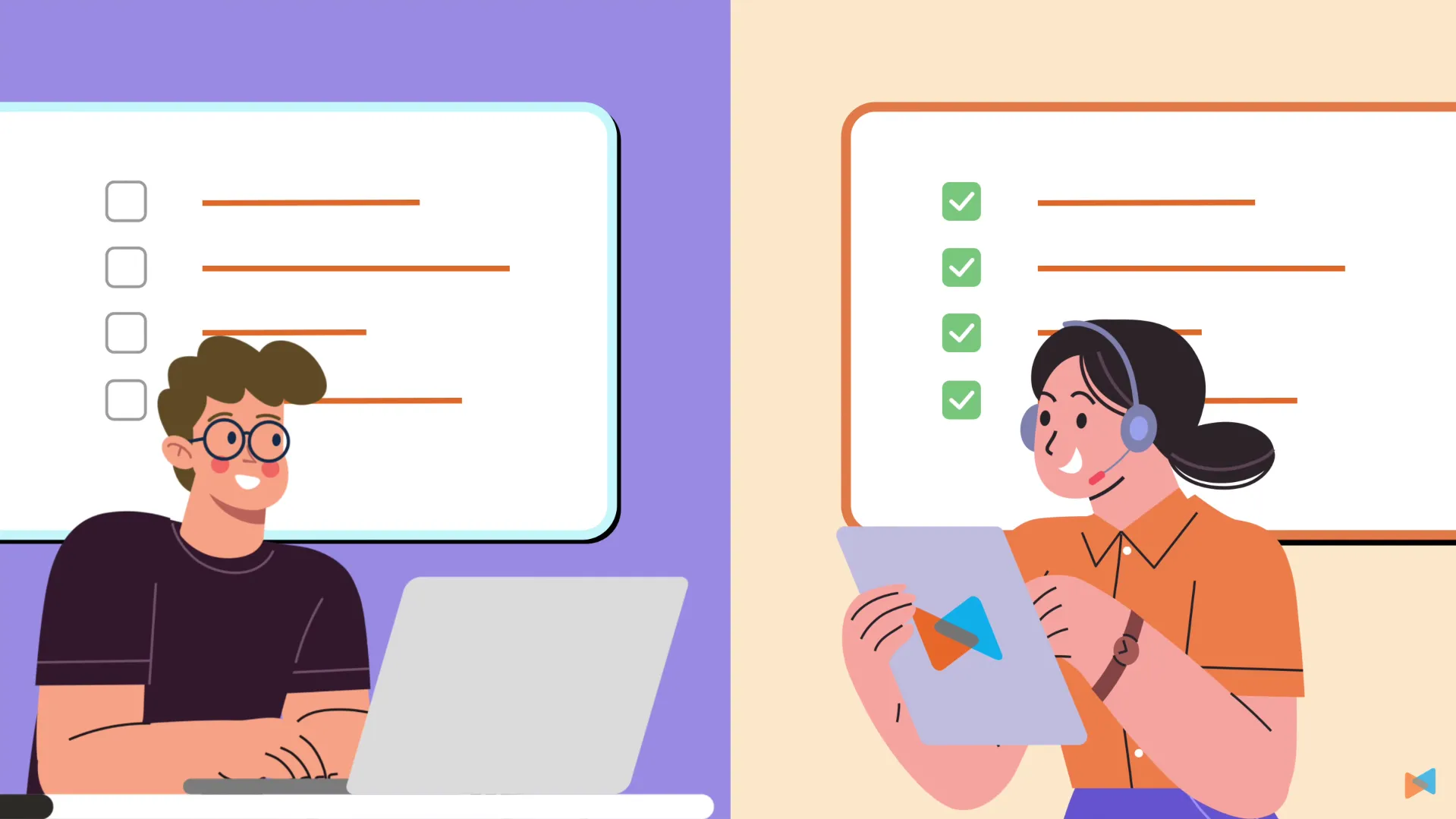
You can upload your file to Google Drive or Dropbox and share access with us. From there, we’ll analyze the structure and make sure everything is aligned before moving forward with the migration to WooCommerce.
Step 2: Customize & run demo migration
Once we’ve reviewed your file, we’ll adjust the data format to match WooCommerce’s requirements. This might involve remapping columns, cleaning up fields, or restructuring the layout so the import goes smoothly.
Before anything goes live, we’ll run a demo migration using a small batch of products. This gives you a clear preview of how the data will look on your WooCommerce store, and a chance to request any changes before we proceed.
Step 3: Perform full migration
After you’ve approved the demo, we’ll move ahead with the full product import. Our team will handle everything from start to finish. During the migration, we closely monitor the process to make sure your WooCommerce product data is transferred cleanly and completely.
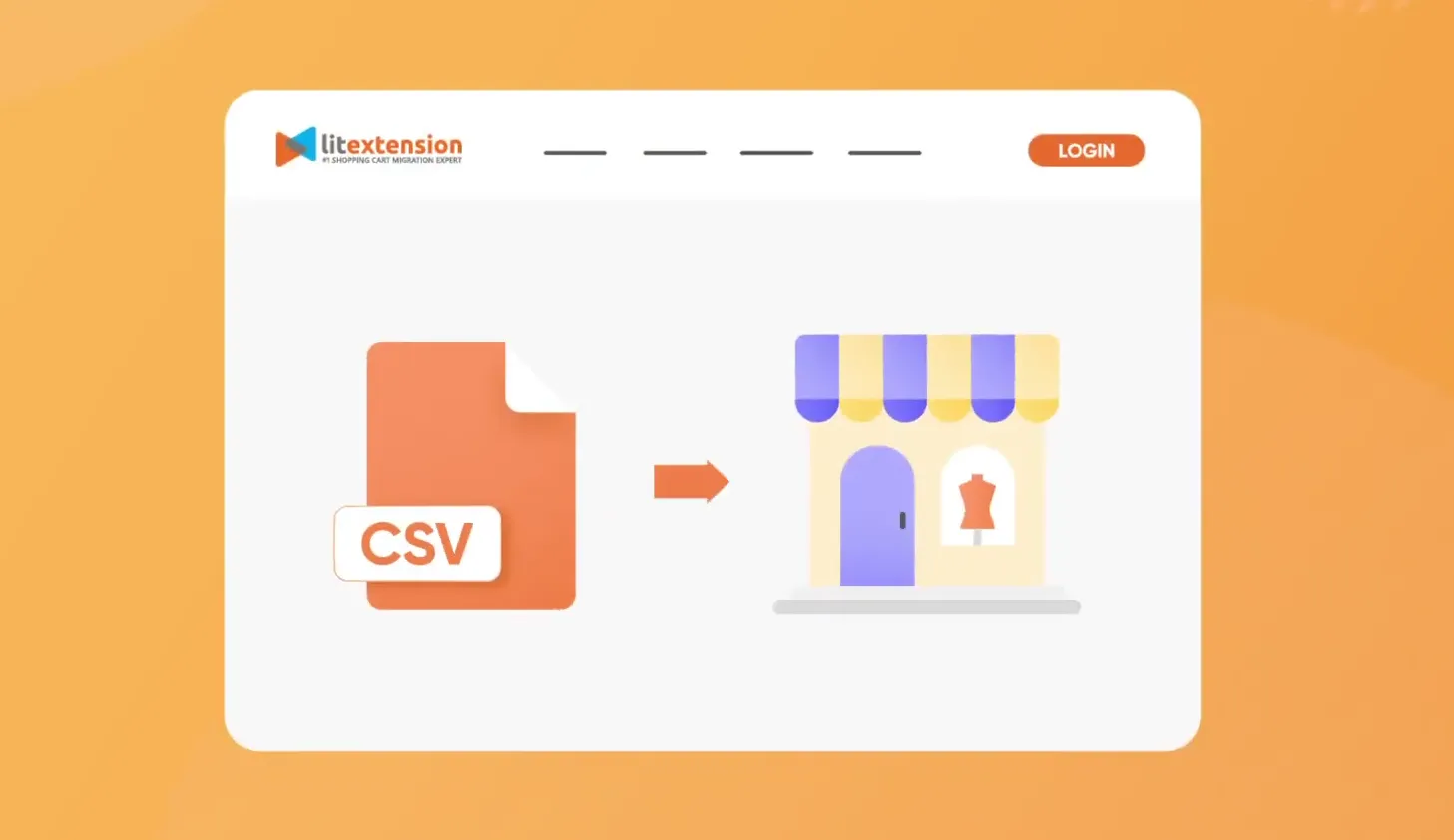
No matter how large or complex your catalog is, we make sure nothing is left behind and that your new WooCommerce store is set up just the way you need it.
Step 4: Test the results
When the WooCommerce import products is complete, we don’t just hand it over and walk away. Our QA team will carefully review the imported products to ensure all key details (names, images, prices, SKUs, stock, and categories, etc.) appear correctly on your site.
We’ll also walk you through the results so you can verify everything looks right on your end. If there’s anything missing or not quite right, we’ll fix it promptly before wrapping up the project.
Want to see how it all works in action? Watch our video walkthrough below for a visual look at the CSV Files Migration Service in action.
And that’s it, your WooCommerce product import is fully handled by our team, with zero manual effort on your part. It's fast, accurate, and tailored to your specific needs.
WooCommerce Import Products, Done Right!
With LitExtension’s experts by your side, you can migrate safely and keep your business running flawlessly.

How to Import WooCommerce Products Using Plugins?
For store owners who prefer a hands-on approach, especially for ongoing updates or smaller catalogs, using a plugin is a flexible alternative. It’s also great if you need extra features like field mapping or scheduled imports. Some of the most popular WooCommerce import tools include WP All Import, Product Import Export for WooCommerce, and Product CSV Import Suite, among others.
In this section, we’ll walk you through how to import WooCommerce products step by step using the WP All Import plugin.
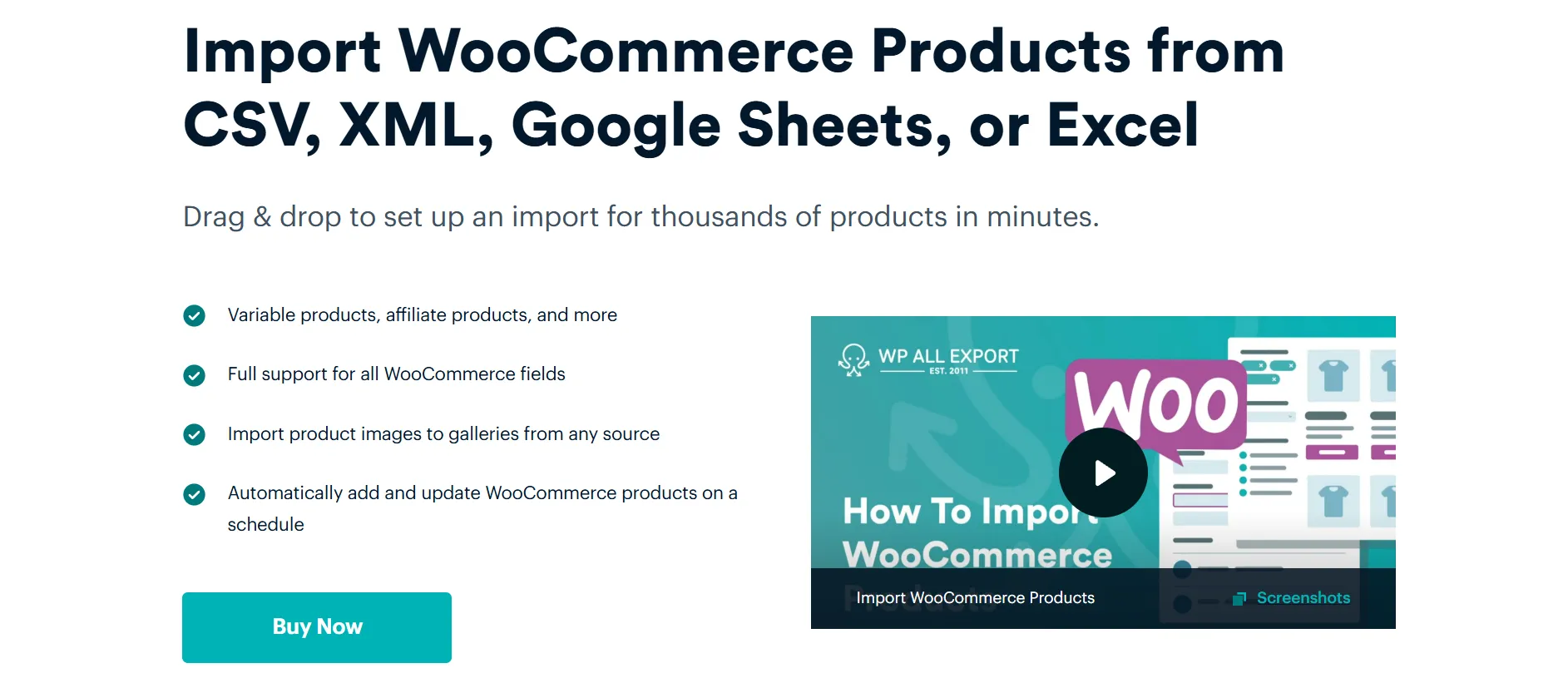
Here's a quick summary of the steps on how to import WooCommerce products using a plugin:
- Step 1: Create a new import
- Step 2: Review your import file
- Step 3: Map data to WooCommerce fields
- Step 4: Configure import settings
- Step 5: Run the import and verify
Step 1: Create a new WooCommerce product import
First, go to All Import > New Import in your WordPress dashboard. Select or upload the file you want to import (CSV, XML, Excel, or even Google Sheets format). After that, choose “WooCommerce product” from the dropdown menu and click “Continue.”
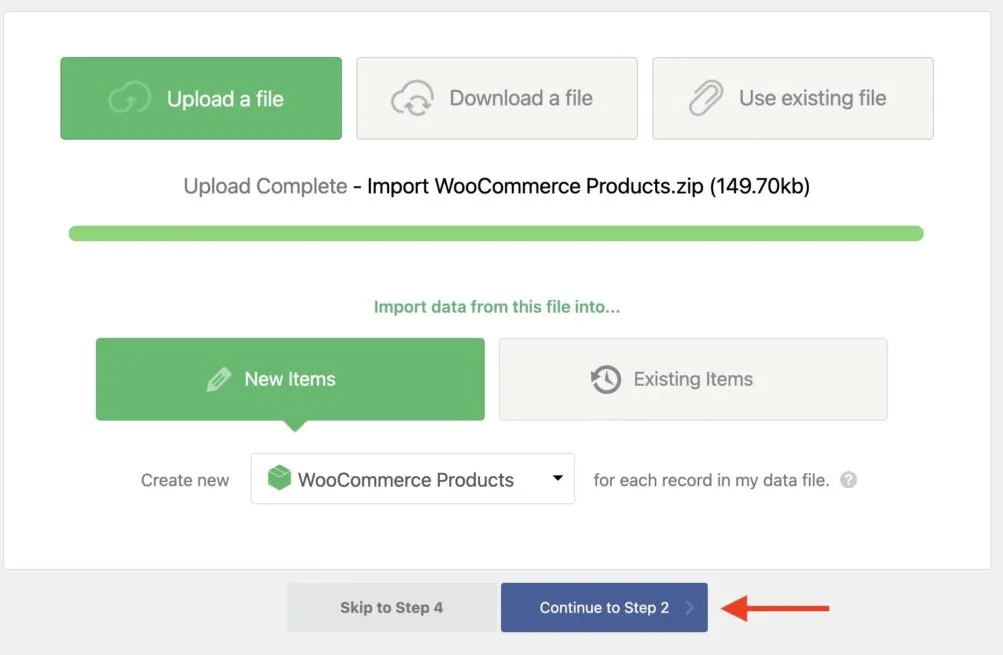
Step 2: Review your import file
On the “Review import file” screen, you can check the data for accuracy:
- If you're importing a CSV or Google Sheets file, adjust the field delimiter (e.g., comma, semicolon).
- If importing an XML or Excel file, choose which parent node to use for the import.
If necessary, use the “Manage filtering options” section (at the screen's bottom) to limit which products get imported. (e.g., only import products above a certain price). Once done, click “Continue” to move on.

Step 3: Map data elements to product fields
Now, you will see a drag-and-drop interface, allowing you to map each field in your import file to the corresponding WooCommerce product fields.
First, drag your data elements to the fields designed for the WooCommerce product title and description. Then, expand the “WooCommerce add-on” section to define the Product type (e.g., Simple, Variable).
After that, configure the product details. There are six tabs to manage this part:
- General Tab: Map fields for SKU, regular price, sale price, and adjust prices if needed. You can also set if the product is virtual or downloadable.
- Inventory Tab: Manage stock settings, stock status, backorder options, and whether the product is sold individually.
- Shipping Tab: Set the product's weight, dimensions, and shipping class.
- Linked Products Tab: Define up-sells, cross-sells, and grouped products.
- Attributes Tab: Import product attributes for better sorting (e.g., color, size).
- Advanced Tab: Set purchase notes, menu order, enable reviews, and set catalog visibility.

After mapping all the necessary fields, click “Continue” to move to Step 4.
Step 4: Configure product import settings
Use the “Auto-detect” button to generate a unique identifier for the import and ensure each product is correctly identified.
Below this section are “Scheduling options” and “Advanced settings,” but in most cases, the current default settings are sufficient for the import. You can revisit these options if needed later. For now, click ‘Continue' to move on.

Step 5: Run the import and verify the results
The “Confirm & run” screen will show a summary of the import settings (which you have configured up to Step 4). Double-check everything, then click “Confirm & run import” to start the import process.

After the import concludes, go to Products > All Products in your WordPress menu to confirm all WooCommerce products were properly imported.
Troubleshooting Common WooCommerce Import Problems
To troubleshoot problems with WooCommerce import products, ensure your CSV file is saved in UTF-8 format and verify that product image URLs are correct and accessible to avoid missing images. For stalled imports or duplicate products, adjust server PHP settings and enable the “Update existing products” option during import.
Problem | Solution |
CSV file not uploading | Ensure the file is saved in UTF-8 format and meets WooCommerce's column formatting requirements. |
Incorrect product categories | Verify that category names in the CSV match the exact names in WooCommerce, including capitalization. |
Variations not linked to products | Make sure the parent product IDs and variation attributes are correctly defined in the CSV. |
Duplicate products created | Enable the "Update existing products" option to match products by SKU or ID during import. |
Import process stalls or fails | Check server PHP settings for memory limits, max execution time, and upload file size; adjust if needed. |
Products not appearing in the store | Confirm the imported products are set to "Published" and have valid stock or visibility settings. |
WooCommerce Import Products: FAQs
How do I import products into WooCommerce?
Go to "All Products" > Products“> "Import.” Upload your CSV file and match up the fields accordingly, then click “Run the importer” to complete the process.
However, if you need additional features, consider using a specialized extension like WP All Import, Product Import Export for WooCommerce, or Product CSV Import Suite for WooCommerce instead.
How do I import products with custom fields in WooCommerce?
To import products with custom fields, you need third-party plugins like WP All Import and Product CSV Import Suite.
An even simpler option is to the LitExtension’s All-in-One package. You can have experts manage the entire migration process and handle your specific needs.
How do I bulk upload products to WooCommerce?
To bulk upload products, use WooCommerce's importer. However, since it's a free tool, this importer handles fewer products than all-in-one services like LitExtension.
How to create an Excel file to import WooCommerce Products?
To create an Excel file for WooCommerce import, simply open Microsoft Excel (or Google Sheets) and start adding your product data in a row-by-row format. Use column headers that match WooCommerce’s CSV format, such as:
- Name
- Description
- Short description
- SKU
- Regular price
- Sale price
- Categories
- Images
Once your data is ready, go to File > Save As, and export the file as a CSV (Comma Separated Values) file. You can then upload it using the WooCommerce built-in product importer.
Final Words
This article has detailed various methods for WooCommerce import products, each with its own advantages.
Nevertheless, to migrate your ENTIRE store to WooCommerce, the best choice is to partner with the LitExtension team. With over 12 years of experience, our LitExtension team has successfully migrated stores for more than 200,000 customers across 100 countries. Count on us to be there for you every step of the way, whether before, during, or even after your WooCommerce migration!
For more information, check out our WooCommerce guides or join our Facebook Community Group.

